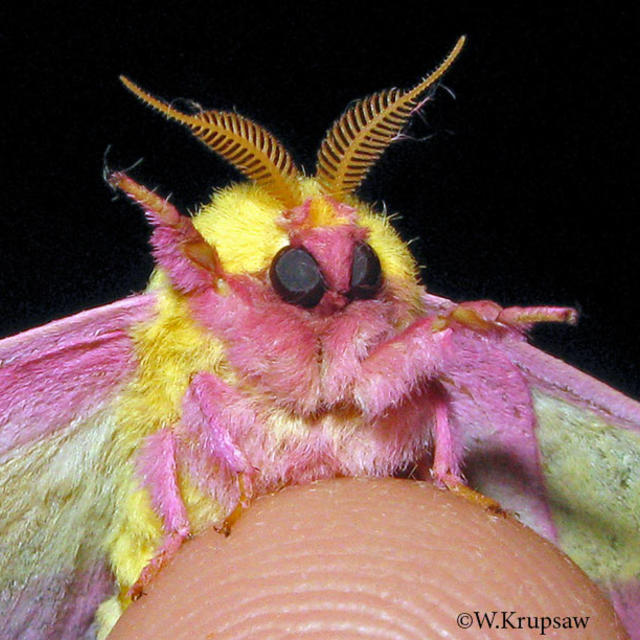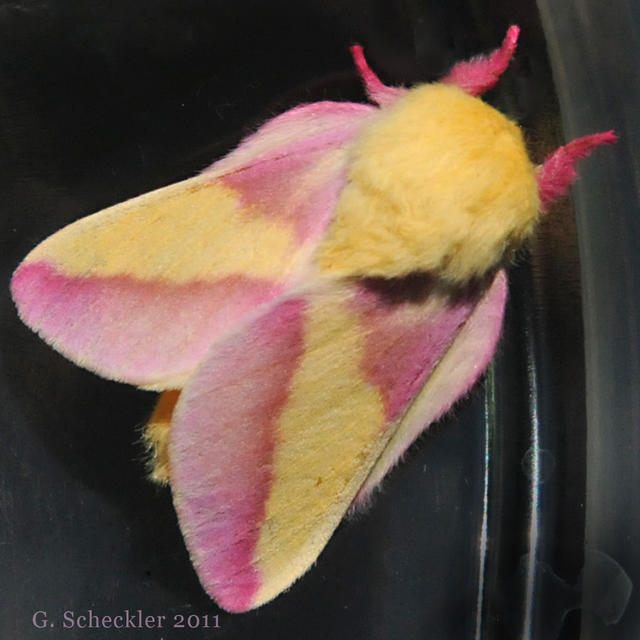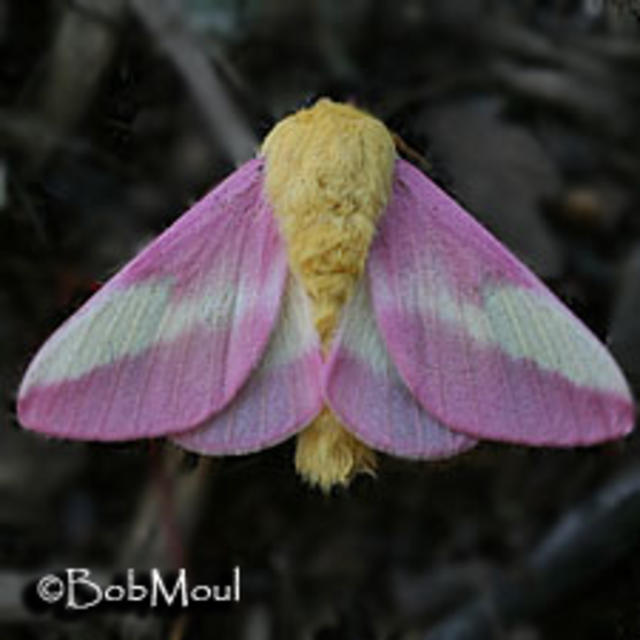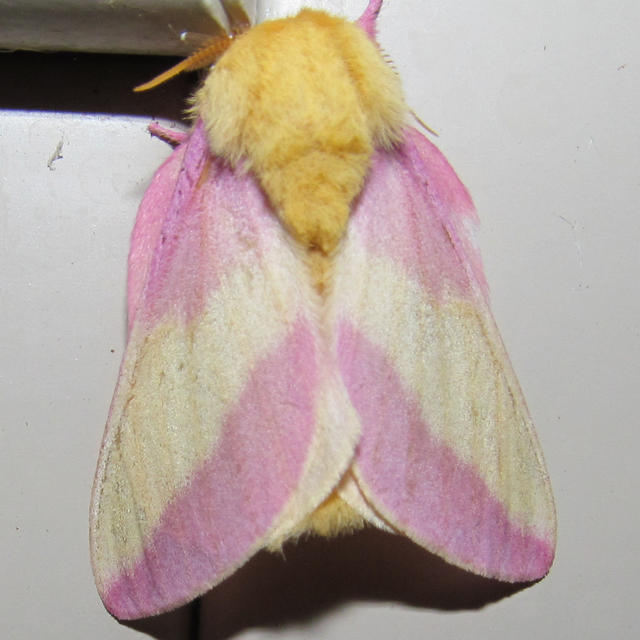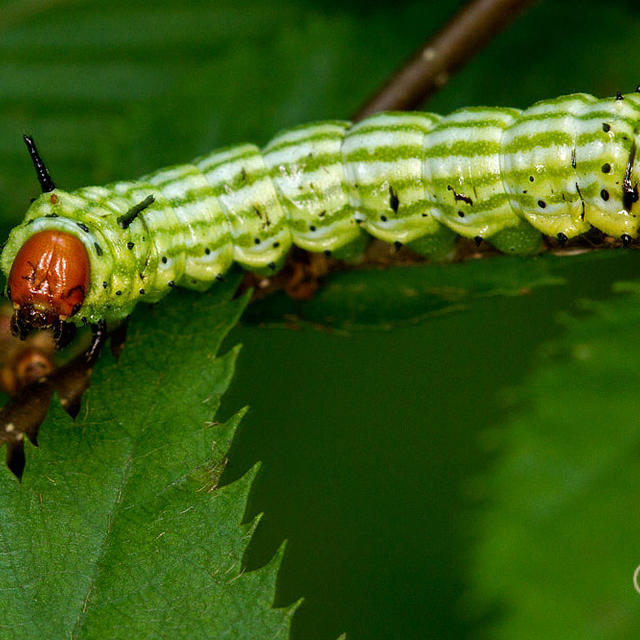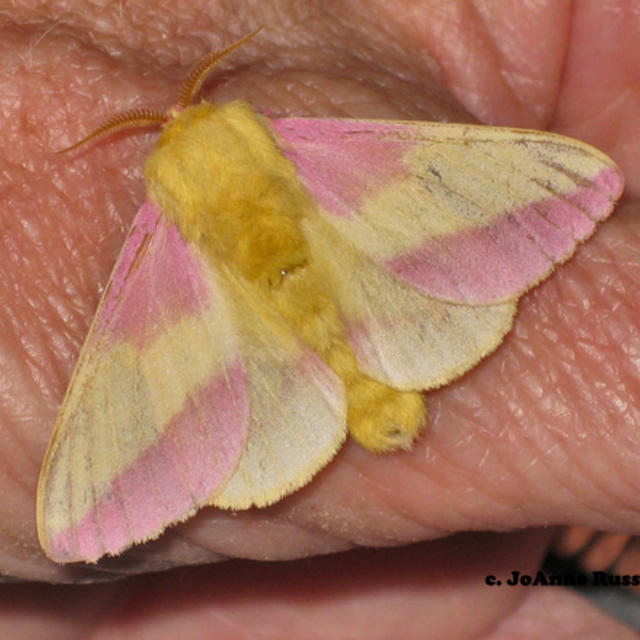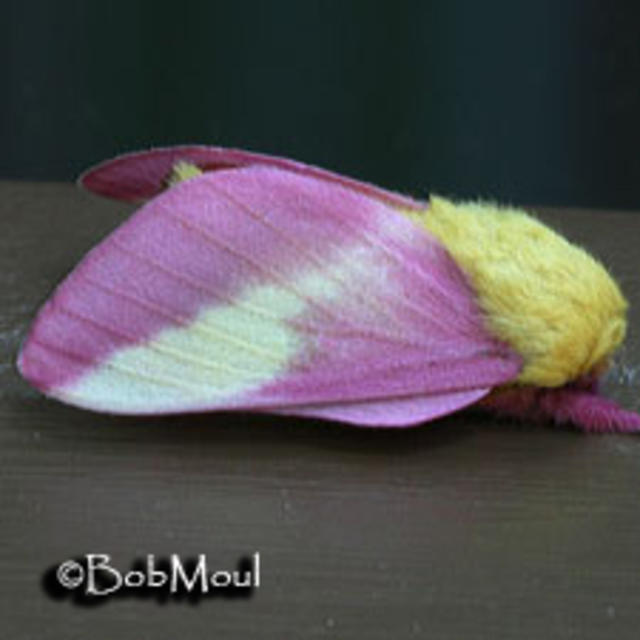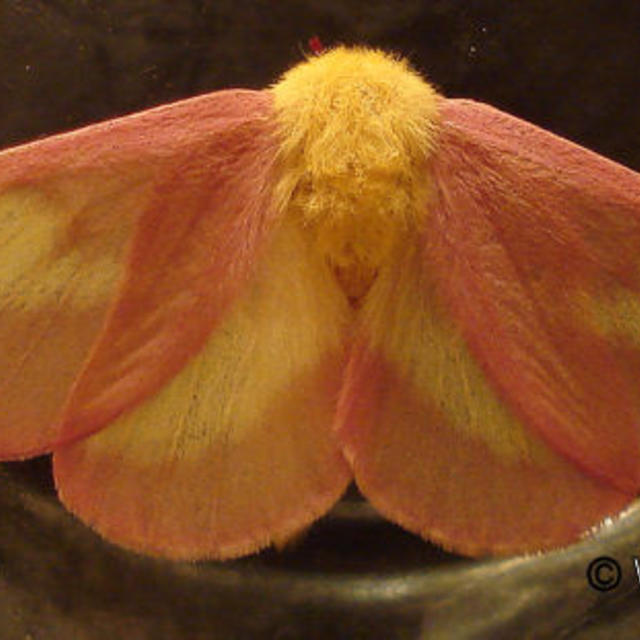Rosy maple moth
Dryocampa rubicunda (Fabricius, 1793)
Family: Saturniidae
Subfamily: Ceratocampinae
Identification: Extremely variable in color. Upperside of wing is yellow to cream to white with pink at the margins and bases of the wings. The amount of pink can vary from covering most of the wing to being absent altogether. Form alba occurs in Missouri and is all white or white with some pink markings.
Wing Span: 1 5/16 - 2 1/16 inches (3.4 - 5.2 cm).
Life History: Adults emerge in the late afternoon and mate in the late evening. Females begin laying eggs at dusk the next day in groups of 10-30 on leaves of the host plant. Eggs hatch in about 2 weeks and feed gregariously when young. Older caterpillars feed alone. Fully-grown caterpillars pupate and overwinter in shallow underground chambers.
Flight: One brood in the north from May-August,two broods in the south from April-September, possibly three broods in the Deep South and Florida from March-October.
Caterpillar Hosts: Maple trees including red maple (Acer rubrum), sugar maple (A. saccharum), and silver maple (A. saccharinum); and oak trees including turkey oak (Quercus laevis).
Adult Food: Adults do not feed.
Habitat: Deciduous forests.
Range: Nova Scotia west through Quebec to Ontario and Minnesota; south to Dade County, Florida, the Gulf Coast, and east Texas.
Conservation: In general, population booms of D. rubicunda are rare, although the caterpillars are occasional pests, defoliating red maple (Acer rubrum), sugar maple (A. saccharum), and silver maple (A. saccharinum); and oak trees including turkey oak (Quercus laevis). Defoliation is generally aesthetic; trees usually survive and recover. Outbreaks are mostly unknown where there is a single brood annually (eastern and northern states, and southern Canada). Like many Saturniids, D. rubicunda is declining across much of its range, possibly due to parasitism by the imported tachinid fly, Compsilura concinnata.
NCGR: G5 - Demonstrably secure globally, though it may be quite rare in parts of its range, especially at the periphery.
Management Needs: None reported.
Taxonomy Notes:
Citation:
- Annals of the Entomological Society of America, Volume 69, Issue 5, 1 September 1976, Pages 857–862, https://doi.org/10.1093/aesa/69.5.857
- Covell, C.V., Jr. 2005. A field guide to moths of eastern North America. Virginia Museum of Natural History, Martinsville, VA.
- Greenstriped Mapleworm. Frank, S. D., Dale, A. 2015. NC State Extension Entomology Insect Notes.
- Green-Striped Mapleworm “Outbreak” in Buchanan County, 2008. Lewis, D. 2018 Iowa State University Extension and Outreach.
- The Green-Striped Maple Worm. Howard, L. O. and F. H. Chittenden. 1909. USDA, Bureau of Entomology. Circular 110, 7
- Wagner, D. L. 2005. Caterpillars of Eastern North America. Princeton (NJ). Princeton University Press. p. 234
Please donate!
We depend on donations to keep Butterflies and Moths of North America freely available. We want to express our gratitude to all who showed their support by making a contribution this year. You can donate to support this project at any time.
Advertise with us!
Do you have a product or service that you think would interest BAMONA users? If you would like to advertise on this website, contact us by email, or use the contact form and select the "Advertising" category.
Verified Sightings
Displaying 1 - 24 of 1598 verified sightings

Observation date: May 27, 2025
Submitted by: Dennis Forsythe (Elizabeth Anderegg)
Region: Greenville County, South Carolina, United States
Verified by: Dennis Forsythe
Verified date: Dec 02, 2025

Observation date: May 29, 2025
Submitted by: jennyshowes
Region: Marshall County, Mississippi, United States
Verified by: stomlins701
Verified date: Sep 10, 2025

Observation date: Jul 07, 2025
Submitted by: Hiraeth
Region: Madison County, Alabama, United States
Verified by: stomlins701
Verified date: Sep 10, 2025

Observation date: May 10, 2025
Submitted by: Michele Pollock
Region: Monroe County, Indiana, United States
Verified by: rogerdowner
Verified date: Aug 31, 2025

Observation date: Jul 22, 2025
Submitted by: Melinda Bell
Region: Sumner County, Tennessee, United States
Verified by: rogerdowner
Verified date: Aug 03, 2025

Observation date: Jul 30, 2025
Submitted by: queen_hwitch_melody
Region: Stafford County, Virginia, United States
Verified by: rogerdowner
Verified date: Jul 31, 2025

Observation date: Jul 26, 2025
Submitted by: Ozark_Bill
Region: Franklin County, Missouri, United States
Verified by: jwileyrains
Verified date: Jul 30, 2025

Observation date: Jun 21, 2025
Submitted by: Shane Miller
Region: Beaver County, Pennsylvania, United States
Verified by: curtis.lehman
Verified date: Jul 28, 2025

Observation date: Jun 28, 2025
Submitted by: Shane Miller
Region: Beaver County, Pennsylvania, United States
Verified by: curtis.lehman
Verified date: Jul 25, 2025

Observation date: Jul 24, 2025
Submitted by: melbeth25
Region: Kanawha County, West Virginia, United States
Verified by: curtis.lehman
Verified date: Jul 25, 2025

Observation date: Jul 22, 2025
Submitted by: Jennshoe90
Region: Virginia, United States
Verified by: rogerdowner
Verified date: Jul 23, 2025

Observation date: Jul 23, 2025
Submitted by: Housesalad
Region: York County, South Carolina, United States
Verified by: rogerdowner
Verified date: Jul 23, 2025

Observation date: Jul 19, 2025
Submitted by: Shane Miller
Region: Washington County, Pennsylvania, United States
Verified by: curtis.lehman
Verified date: Jul 22, 2025

Observation date: Jul 13, 2025
Submitted by: Bflymom
Region: Berks County, Pennsylvania, United States
Verified by: curtis.lehman
Verified date: Jul 13, 2025

Observation date: Jun 13, 2025
Submitted by: Daniel Morton
Region: Somerset County, New Jersey, United States
Verified by: curtis.lehman
Verified date: Jul 08, 2025

Observation date: Jun 25, 2025
Submitted by: SWilliams
Region: York County, Maine, United States
Verified by: Sue Gregoire
Verified date: Jun 26, 2025

Observation date: Jun 26, 2025
Submitted by: ghostyxs
Region: Cumberland County, Maine, United States
Verified by: Sue Gregoire
Verified date: Jun 26, 2025

Observation date: Jun 20, 2025
Submitted by: dnight30
Region: Carroll County, New Hampshire, United States
Verified by: rogerdowner
Verified date: Jun 21, 2025

Observation date: Jun 17, 2025
Submitted by: dnight30
Region: Carroll County, New Hampshire, United States
Verified by: rogerdowner
Verified date: Jun 18, 2025

Observation date: Jun 17, 2025
Submitted by: dnight30
Region: Carroll County, New Hampshire, United States
Verified by: rogerdowner
Verified date: Jun 18, 2025

Observation date: Jun 06, 2025
Submitted by: Team-Chick
Region: Gloucester County, Virginia, United States
Verified by: rogerdowner
Verified date: Jun 08, 2025

Observation date: Jun 01, 2025
Submitted by: dnight30
Region: Carroll County, New Hampshire, United States
Verified by: rogerdowner
Verified date: Jun 08, 2025

Observation date: May 29, 2025
Submitted by: Bradleysogoba
Region: Franklin County, Massachusetts, United States
Verified by: rogerdowner
Verified date: May 29, 2025

Observation date: May 19, 2025
Submitted by: dmes004
Region: Connecticut, United States
Verified by: jwileyrains
Verified date: May 21, 2025
- 1 of 67
- next ›

